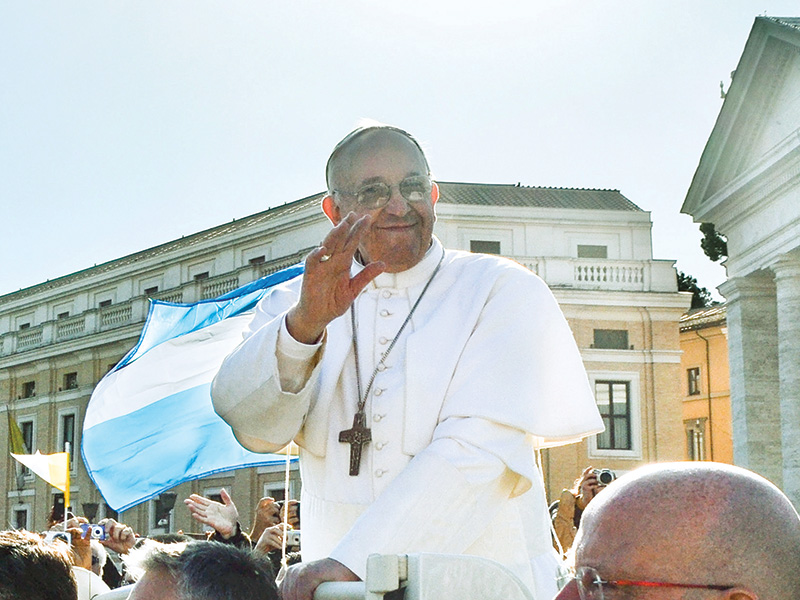A Jesuit Heart
Members of the Loyola community reflect on Pope Francis’ legacy
George P. Matysek, Jr., ’94
 Photo taken by Laura Griffin, '14, while studying in Rome
Photo taken by Laura Griffin, '14, while studying in Rome
As Pope Francis’ health visibly declined in his final months, the Rev. Thomas O’Donnell regularly joined hundreds in St. Peter’s Square for a nightly rosary.
“It was a reminder of the universality of the Church, and that Rome is filled with Italians and non-Italians from all over the world who are there to support the Holy Father. They gather around him in moments of happiness and victory—and also in moments of difficulty and illness,” remembered Fr. O’Donnell, a 2015 Loyola graduate.
Fr. O’Donnell first came to Rome to study abroad as a Loyola student, in part, because of the moment when Cardinal Jorge Bergoglio emerged on the balcony of St. Peter’s Basilica as Pope Francis. He watched that historic moment with roommates in Loyola’s Campion Tower.
Later, as a seminarian who was studying for the Archdiocese of Baltimore at the Pontifi cal North American College, the Maryland native spent an additional four years there, seeing the Jesuit pope many times and once shaking his hand.
“He challenged us to always ask, ‘Am I really pushing myself to stand at the margins of the Church and see what it looks like at those edges?’” said Fr. O’Donnell, a double major in English literature and theology.
The Rev. Steve Spahn, S.J., assistant teaching professor of theology and assistant to the director of mission integration at Loyola, said that approach reflected the Jesuit founder’s belief that renewal begins not with power, but with presence.
“St. Ignatius taught that if people are leaving the Church, then it would behoove us to be better priests, better preachers, better bishops, and better Christians,” Fr. Spahn said.
He added that Pope Francis embodied the Jesuits’ Spanish name—“Companions of Jesus”—especially in his outreach to those who often feel marginalized. “If you understand yourself as moving in the world at Christ’s side—as his companion—then, of course, you want to be at everyone’s side.”
While critics sometimes faulted Francis for lacking clarity, Fr. Spahn saw pastoral sensibility. In cases such as divorced and remarried Catholics longing to receive the Eucharist, for example, the Holy Father allowed for the possibility of receiving the sacrament in certain situations. He recognized life’s complexity, Fr. Spahn said.
“Early on, Pope Francis used that image of the Church as a fi eld hospital,” Fr. Spahn said. “If someone’s bleeding out on the tarmac, you’re not worried about their blood pressure or their cholesterol levels or their bursitis. You get to the wound.”
On Easter Sunday, the day before Pope Francis died, Fr. O’Donnell stood just a few feet away when the Holy Father rode by in his popemobile. A deacon at the time, he served at one of the nine “novendiali” Masses of mourning for the pope.
“My whole priesthood will be marked by his continuing invitation to live in poverty as much as I can,” he said.
The Rev. Gregory Chisholm, S.J., superior of the Baltimore Jesuit community, participated in an August pilgrimage of about 30 Loyola community members to Rome, where he prayed for his Jesuit brothers at Pope Francis’ tomb.
“Pope Francis took a special interest in those who are on the margins of our economic, political, ethnic, and racial divide,” Fr. Chisholm said. “We are fortunate that he is being followed by Pope Leo—a man who takes a very similar interest.”